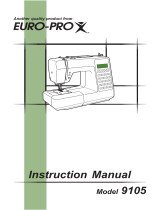
Contents
Before use
• Important safety instructions
.............................................
4
• How to change the power plug
.........................................
6
• Part names
.......................................................................
8
• How to use handwheel
................................................... 10
• How to use presser foot lever
......................................... 10
• How to use reverse sewing lever
.................................... 10
• How to remove extension table
....................................... 10
• How to use quick adviser
................................................ 11
Sewing preparations
• Connecting the power
.....................................................
12
• Installation of battery for winding the lower thread
..........
13
• Winding the lower thread
................................................
14
• Threading the lower thread
.............................................
16
• Threading the upper thread
............................................
17
• Pulling up the lower thread
.............................................
19
• Application of each stitch pattern
.................................... 20
• Changing the presser foot
............................................... 21
• Changing the needle
.......................................................
23
• Relationship between the needle, thread and
fabric, and adjusting the thread tension
..........................
24
Sewing
• Straight stitching and reverse sewing
.............................
25
• Zigzag sewing
.................................................................
28
• Adjusting thread tension
................................................. 30
• Buttonhole sewing
.......................................................... 31
• Overcasting
.....................................................................
34
• Zipper insertion
...............................................................
35
• Blind hem stitching
..........................................................
37
Maintenance
• Feed dog and hook maintenance
...................................
39
• Changing light bulb
......................................................... 41
• Troubleshooting
...............................................................
42
• Servicing double-insulated products (230V-240V)
..........
44
Others
• Safety precaution about the battery
................................
44
• Recycling
.......................................................................
45
• Specifi cations
..................................................................
46
Before use
Sewing
preparations
Sewing
Maintenance
Others




















